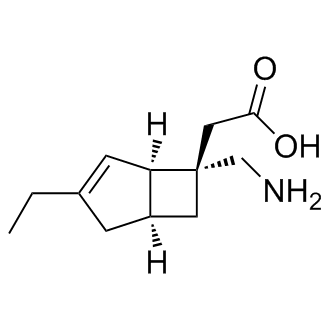| References: |
Mirogabalin (DS-5565) is a novel, preferentially selective α2δ-1 ligand characterized by high potency and selectivity to the α2δ-1 subunit of voltage-sensitive calcium-channel complexes in the CNS.
Mirogabalin (DS-5565) is a novel, preferentially selective α2δ-1 ligand characterized by high potency and selectivity to the α2δ-1 subunit of voltage-sensitive calcium-channel complexes in the central nervous system (CNS). In vitro experiments using membrane preparations from human and rat α2δ subunit-expressed cells show that Mirogabalin had a slower dissociation rate from α2δ-1 than α2δ-2, in particular, α2δ-1 compared with Pregabalin. Additionally, Mirogabalin shows potent, sustained analgesic effects in streptozotocin-induced diabetic rats with induces pain, and the superior analgesic effects and wider CNS safety margin relative to Pregabalin are attributed to its selectivity for and slow dissociation from α2δ-1 compared with Pregabalin. Mirogabalin (DS-5565) is an α2δ-1 ligand being developed for pain associated with diabetic peripheral neuropathy, fibromyalgia, and postherpetic neuralgia. Mirogabalin targets α2δ-1, an auxiliary protein associated with voltage-sensitive calcium channel complexes in the central nervous system. This binding reduces calcium influx at nerve terminals, therefore reducing the release of several pain neurotransmitters. The ED50 (on the transformed scale) for Mirogabalin is estimated to be 20.5 mg with a 90% confidence interval (CI) of 10.1-41.7 mg.
InVivo: Additionally, Mirogabalin shows potent, sustained analgesic effects in streptozotocin-induced diabetic rats with induced pain, and the superior analgesic effects and wider central nervous system (CNS) safety margin relative to Pregabalin are attributed to its selectivity for and slow dissociation from α2δ-1 compared with Pregabalin. |























